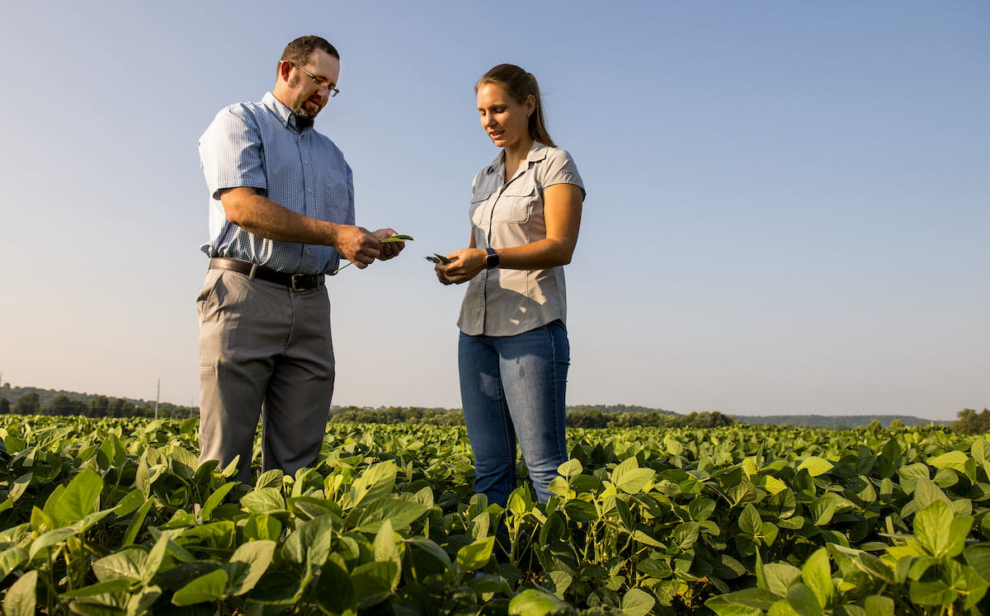Weather. Markets. Global events. Farmers still have to produce the world’s food amid a world of uncontrollable factors.
“Any farmer will tell you that farming is a lot like gambling,” said Andrew Anderson, assistant professor of agricultural economics and agribusiness for the U of A System Division of Agriculture. “To be able to have policies that are created understanding that risky environment is really important.”
Anderson investigates the role of risk in decisions throughout the agricultural supply chain. He said he is hoping his research will improve policy-making decisions and help farmers and others develop strategies to manage risky environments.
Risk can come from various sources for agricultural producers, Anderson said. Two especially significant factors are uncertainty in the final price and production quantity — price risk and production risk. Farmers make production decisions long before they know the price, and uncontrollable variables such as weather make it difficult to predict production outcomes.
Some economics research assumes risk is not a factor, which might not provide an entirely realistic scope, Anderson said. The economists who work specifically on risk help offer a more complete picture of the economic environment.
Anderson joined the U of A System in August. He conducts research for the Arkansas Agricultural Experiment Station, the research arm of the Division of Agriculture. He also teaches classes through the Dale Bumpers College of Food, Agricultural and Life Sciences at the U of A. Anderson is part of the Fryar Price Risk Management Center of Excellence in the Agricultural Economics and Agribusiness Department.
“Agriculture is such a unique industry,” Anderson said. “As long as we have people on the planet to feed, improving the production and distribution of that food can have a real impact on people’s lives.”
John Anderson, head of the Agricultural Economics and Agribusiness Department, is excited that Anderson joined the department because of his extensive background in applied research related to commodity price behavior and risk management.
“His experience and expertise are an excellent fit for the issues and challenges that we face in agriculture here in Arkansas, and his skill set is a great complement to the personnel that we already have in place in the department,” he said. “I look forward to seeing the contribution that Andrew will be able to make across all of the mission areas of the department: research, teaching and extension.”
POLICY, RISK AND FUTURES MARKET
Part of Anderson’s research focus relates to the intersection of government policy and producer risk. One of his ongoing projects aims to determine how drought insurance impacts the demand for pastureland. Drought insurance, officially known as Rainfall Index Pasture, Rangeland and Forage insurance, helps protect a producer’s operation from the risk of forage loss due to lack of precipitation. Anderson said that government policy interacts with the price and quantity of pastureland in interesting ways.
Government policy may have unintended consequences, Anderson said. For example, policy makers might design a program to benefit livestock producers by reducing risk. However, if much of the value of the program is capitalized into land values, the large share of producers who rent land won’t benefit as rental rates increase and the benefits are passed on to landlords.
Anderson’s projects also explore volatility in the cattle futures market, which helps with price discovery and risk management, Anderson said. Through the futures market, people buy and sell contracts settled at a future date, Anderson explained. There are concerns that cattle futures markets experience excessive volatility, due to a variety of factors. Anderson’s research aims to address the source of this volatility and find the impact excess volatility on price discovery and risk management for cattle producers.
Cattle producers use the futures market to hedge against large price movements. A volatile futures market makes it difficult to accomplish this goal. Volatility could also spill over into local cash markets, increasing uncertainty and risk even for those who don’t use futures contracts as a hedge.
In addition to his cattle market projects, Anderson said he plans to expand his research to other agricultural commodities in Arkansas, such as poultry and rice. Anderson hopes that his research will support stakeholders in Arkansas and the land-grant mission.
Anderson received his bachelor’s degree in agricultural economics from Brigham Young University–Idaho in 2017. He earned master’s and doctoral degrees also in agricultural economics from Purdue University in 2019 and Kansas State University in 2023, respectively.
To learn more about Division of Agriculture research, visit the Arkansas Agricultural Experiment Station website: https://aaes.uada.edu/. Follow us on X at @ArkAgResearch. To learn more about the Division of Agriculture, visit https://uada.edu/. Follow us on Twitter at @AgInArk.
About the Division of Agriculture: The University of Arkansas System Division of Agriculture’s mission is to strengthen agriculture, communities, and families by connecting trusted research to the adoption of best practices. Through the Agricultural Experiment Station and the Cooperative Extension Service, the Division of Agriculture conducts research and extension work within the nation’s historic land grant education system. The Division of Agriculture is one of 20 entities within the University of Arkansas System. It has offices in all 75 counties in Arkansas and faculty on five system campuses.
The University of Arkansas System Division of Agriculture offers all its Extension and Research programs and services without regard to race, color, sex, gender identity, sexual orientation, national origin, religion, age, disability, marital or veteran status, genetic information, or any other legally protected status, and is an Affirmative Action/Equal Opportunity Employer.
Source: University of Arkansas










